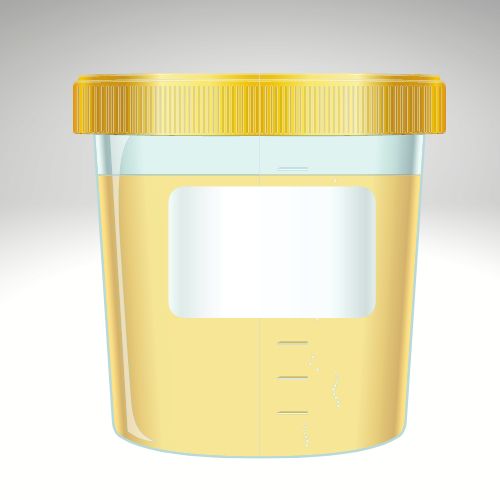Bloody Urine in Elderly Women: 7 Main Causes.
Our content is not intended nor recommended as a substitute for medical advice by your doctor. Use for informational purposes only.
Key facts
The most common causes of blood in urine in elderly women are UTI, stones, and bladder cancer. Other causes include trauma, vigorous exercise, glomerular disease, medications, etc.
Some clues to diagnosing the cause of hematuria in an older woman:
| CAUSE | LANDMARK FEATURES |
|---|---|
| 1. UTI | Hematuria is associated with burning urination, frequent urge to pee, bladder pain, and turbid urine. Some cases may have a fever, chills, or flank pain. |
| 2. Stones (in kidneys, ureter, or bladder). | Prior or current history of characteristic kidney or ureter pain. |
| 3. UB cancer | painless hematuria in an elderly woman with risk factors such as smoking or opium use. |
| 4. False hematuria. | Due to vaginal bleeding, not hematuria. |
| 5. Exercise-induced hematuria | After strenuous exercises or vigorous contact sports. |
| 6. Urethral diverticulum | tender mass in the anterior vaginal wall. It is often associated with UTI symptoms such as dysuria, frequency, and incontinence. |
| 7. Urinary tract trauma. | Recent history of trauma to the urinary tract (the kidneys, ureters, bladder, or urethra). |
1. UTI
UTI is the most common cause of blood in urine in elderly women. In addition, studies show that UTI is the most common infectious illness in elderly women aged 65 years and above (reference).
Severe Urinary tract infections cause blood in the urine (hematuria) in older women. The presence of bloody urine, together with symptoms such as burning urination, frequency, an urgency to urinate, and bladder pain, is suggestive of UTI.
Risk factors of UTI in older women:
- Being a woman is a natural risk factor for UTI due to the shorter urethra making it easier for the infectious organisms to reach the urinary bladder.
- Diabetes Mellitus.
- Disabled (bed-ridden) elderly women.
- Chronic catheterization.
- Recent sexual intercourse.
- Prior history of urinary tract surgery.
- Urine incontinence.
Symptoms of UTI in elderly women:
UTI can be simple (confined to the urinary bladder) or complicated. Complicated UTI is a term used to describe UTI extending beyond the urinary bladder (kidney infection or systemic infection).
Symptoms of acute cystitis (uncomplicated UTI):
- Dysuria (pain during urination).
- Urinary frequency.
- Frequent waking up to pee at night (nocturia).
- Sudden urge to pee (urgency):
- Bladder pain (suprapubic pain):
- Blood in the urine (hematuria):
- Cloudy (turbid urine).
Symptoms of complicated UTI include (reference):
- All the classic symptoms of acute cystitis (dysuria, urgency, frequency, blood in urine, etc.).
- Fever >37.7°C (>99.9°F).
- Chills or rigors.
- Significant fatigue, muscle aches, or any other feature of systemic illness.
- Flank pain.
- Pelvic or perineal pain in men.
- Tenderness over the kidney area when your doctor examines it (A tender costovertebral angle at the upper back just below the ribs).
What to expect:
UTI is the most likely cause of blood in urine if you are an elderly woman. Call your doctor if you have symptoms suggestive of infection (listed above).
Your doctor will diagnose UTI based on urine tests (urine culture). However, he may need other investigations to exclude other causes of blood in urine as abdominal ultrasound or CT scan of the urinary tract.
Bladder and kidney cancer should be excluded in elderly women with UTI.
2. Stones.
The stones in the urinary tract are often formed inside the kidney. However, they eventually move and may reach the ureter, the urinary bladder, or the urethra.
Urinary or kidney stones commonly cause bloody urine in elderly females.
A large study found that urinary tract stones are more common in women than in men. Also, older ages (>60 years) are another risk factor for urinary stones.
Symptoms of stones in the urinary system:
- Kidney stones cause loin pain (in the flanks and upper back on both sides).
- Bladder stones often cause central pelvic pain (urinary bladder pain).
- Ureteric stones cause severe flank pain that radiates to the groin and the inner thigh.
- Some cases are completely asymptomatic and may present with isolated blood in the urine.
- The pain is often sudden onset, severe, and colicky and may last minutes to hours.
- Turbid urine.
- The pain may be associated with nausea and/or vomiting.
- Blood in the urine.
- Obstruction of the urine outflow can also occur in severe cases.
Urinary stones are often diagnosed by an imaging study such as an X-ray, ultrasound, or CT scan of the urinary tract.
Learn more about urinary stones.
3. Cancer (UB or kidney cancer).
Malignancy is often more common in the elderly. And both urinary bladder and kidney cancer cause blood in the urine.
You should consider bladder cancer as a cause of blood urine, especially if you have risk factors such as:
- Cigarette smoking.
- Females are generally less commonly affected by bladder cancer than men.
- Being older (more than 50).
- Opium use.
- Occupation exposure to carcinogens as with metal workers, painters, rubber industry workers, leather workers, textile and electrical workers, miners, cement workers, transport operators, excavating-machine operators, and jobs that involve the manufacture of carpets, paints, plastics, and industrial chemicals.
- Genetics also plays a role.
- Schistosomiasis infection (common in north Africa and Japan).
For kidney cancer, the risk factors are nearly the same, plus obesity, older age, hypertension, and a family history of kidney cancer.
Symptoms of urinary bladder cancer:
- Early bladder cancer may present with irritative symptoms such as painful urination (dysuria), the urgency to urinate, or frequent urination.
- Typically, bladder cancer causes painless bleeding in the urine (intermittent attacks of bloody urine or blood on tissue after urination).
- Blood is often present throughout the urination, but minor bleeding also occurs.
- Bladder pain or pressure in the lower abdomen (typically, no pain is present in patients with bladder cancer).
- Dysuria or pain after the end of urination.
- Signs of metastasis may also exist, such as bone pain, abdominal pain, liver pain, headache, or blurring of vision.
- Weight loss, anorexia, and other systemic symptoms may also present.
The symptoms of kidney cancer are the same, except the pain is often in the flanks. 25% of the cases of kidney cancers are completely asymptomatic.
Due to the higher risk of cancer in older ages, Any woman with blood in her urine should undergo investigations to exclude kidney and urinary bladder cancers.
3. Glomerular diseases.
The glomeruli present in the kidney cortex (outer part of the kidney) and inflammation of the glomeruli (glomerulonephritis) may cause blood in the urine (reference.
Common glomerular diseases causing hematuria include (reference):
- Post-infectious glomerulonephritis.
- IgA nephropathy.
- Vasculitis.
- Anti-GBM disease.
- Hereditary nephritis.
Symptoms suggestive of glomerular disease:
- Flank pain.
- Prior history of sore throat or respiratory infection.
- Flank pain.
- Severe headache (due to hypertension).
- Bloody urine (Pink or cola-colored urine).
- Decreased amount of urine.
- Foamy or bubbly urine (proteinuria).
- Nausea or vomiting.
- Flank pain.
- Fatigue and muscle cramps.
- Edema in the eyes or limbs.
4. False hematuria.
The female reproductive system is a common source of bleeding that may contaminate urine during wiping with a tissue giving a false impression of bloody urine (hematuria).
So it is important for you as a female to inspect the area around the urethral and vaginal openings to accurately determine the source of bleeding (urethral versus vaginal).
Common causes of vaginal bleeding that may mimic blood in the urine (with no pain):
- Vaginal atrophy (post-menopausal).
- Menses or post-menopausal bleeding.
- Uterine or cervical malignancy.
- Recent sexual intercourse.
- During the times before and just after menopause (perimenopausal bleeding).
- Others (not common in elderly women):
- Use of OCPs.
- Pregnancy.
- Ectopic pregnancy.
- Intrauterine device (IUD).
- Miscarriage (before the 20th week of pregnancy).
- Spotting (due to hormonal fluctuations).
5. Exercise-induced hematuria.
Transient hematuria in elderly women who habitually perform sports such as running or swimming may be exercise-induced.
In most cases, the hematuria is temporary and clears within a few days after the exercise with no need for further investigations.
Exercise-induced hematuria can occur with (reference):
- Vigorous contact sports such as boxing and football.
- Non-contact sports such as marathon running, rowing, and swimming.
- It can also occur with long-distance cycling (but rare).
Possible mechanisms (reference):
- Traumatic: trauma to the kidneys or the urinary bladder with vigorous contact sports or long-distance running.
- Blood shifting from the kidneys to the muscle leads to ischemic inflammation of the kidneys.
- Lactic acidosis from excessive muscle work makes your kidneys more permeable to red blood cells (hence the blood appears in urine).
Symptoms and features:
- Often starts after stressful or prolonged sports such as boxing, football, marathon running, etc.
- It may be associated with bladder or kidney pain.
- The condition improves with rest (after a few days to one week).
- Often, it doesn’t lead to significant kidney disease or kidney failure.
- Imaging studies (such as Ultrasound or CT scans) are often normal.
- Your doctor should thoroughly investigate hematuria that continues for more than a week from the last exercise.
- Exercise-induced hematuria in people above 50 should also be investigated thoroughly due to the high risk of bladder cancer.
6. Urethral diverticulum.
The urethral diverticulum is a localized dilatation or pouch in the female urethra (common in the middle portion of the urethra).
Urethral diverticulum is a common condition affecting up to 5% of women (reference). Also, it is often diagnosed at older ages; one study found that the median age at diagnosis is 46.
About 9.1% of women with urethral diverticulum may present with bloody urine (hematuria).
The diverticulum can cause pain or discomfort in the female urethra without UTI. Also, it can cause blood on tissue after urination in females.
Symptoms (reference):
- Urethral pain (may be in the form of mild discomfort or weird feeling without frank pain).
- Dripping of urine after peeing.
- A sense of tender mass in the vaginal wall.
- Painful intercourse.
- Dysuria (pain during urination).
- Chronic or recurrent UTIs.
- Increased frequency of urination with urinary urgency.
- Bloody urethral discharge. The blood may appear during or after urination. It also may appear on the tissue after peeing).
- Urinary incontinency.
- Urine retention.
7. Trauma.
Trauma to the kidney, ureters, urinary bladder, or urethra may cause blood in the urine. In addition, older women are more prone to trauma, such as falling.
Always try to remember any trauma in the past few days before the appearance of the bloody urine.
Urinary tract trauma often results from:
- Recent urinary catheter insertion.
- Recent cystoscopy ( a cystoscope is a small device that allows your doctor to see the inside of the urinary bladder. It is introduced through the urethra).
- Major pelvic trauma (as with road traffic accidents).
- Kidney trauma (blunt trauma to the flanks).
- Vigorous contact sports.
The trauma is often minor (with a normal CT scan and ultrasound results). However, a history of a recent catheterization or trauma to the urinary tract is an important clue.
7. Others.
The table below illustrates all the possible causes of hematuria (reference).
| KIDNEY CAUSES |
|---|
| 1. benign or malignant kidney tumors. |
| 2. Glomerulonephritis (IgA nephropathy, Thin basement membrane disease, or Alport syndrome). |
| 3. Adult Polycystic Kidney Disease (APKD) |
| 4. Medullary sponge kidney. |
| 5. Pyelonephritis (kidney infection). |
| 6. Kidney distension with urine (hydronephrosis). |
| 7. Increased excretion of calcium or uric acid in urine. |
| 8. Severe (malignant) hypertension. |
| 9. Obstruction of the renal artery or renal vein. |
| 10. Arteriovenous malformation (abnormal blood vessels of the kidney). |
| 11. Papillary necrosis (with sickle cell disease). |
| URETERIC CAUSES |
| 1. Malignant ureteric tumor. |
| 2. Stone ureter. |
| 3. Stricture (narrowing) in the ureter. |
| 4. Polyp. |
| 5. Post-surgery (fistula between the iliac vessels and the ureter or ureteroiliac fistula). |
| URINARY BLADDER CAUSES |
| 1. UB cancer (most serious). |
| 2. Cystitis (UTI). |
| 3. UB stone. |
| 4. UB radiation. |
| PROSTATE & URETHRA |
| 1. BPH (benign prostatic hypertrophy). |
| 2. Prostatic cancer. |
| 3. Prostatic procedures such as taking a biopsy or operations. |
| 4. Trauma during urinary catheter insertion. |
| 5. Urethritis (inflammation of the urethritis). |
| 6. Urethral diverticulum. |
| ANYWHERE (KIDNEY, URETER, BLADDER, OR URETHRA) |
| 1. UTI (infection with bacteria, viruses, or fungi). |
| 2. Tuberculosis. |
| 3. Schistosomiasis |
| 4. Trauma. |
| 5. Exercise-induced hematuria. |
| 6. Recent interventions such as lithotripsy. |
| 7. Bleeding disorders or anticoagulant medications. |
| 8. Endometriosis of the urinary tract. |
| 1. Menstruation. |
| 2. Drugs (Pyridium, phenytoin, rifampin, nitrofurantoin). |
| 3. Red pigments in urine as myoglobinuria |
| 4. Beeturia. |
- Evidence-based
- Written by a doctor.
MD, Internal Medicine and Nephrology specialist.

Dr. Esraa A. MagidAuthor
MORE INSIGHTS





